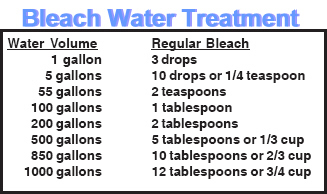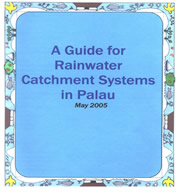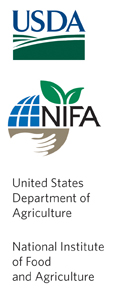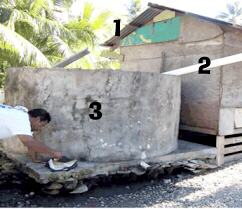________________________
|
_________________________________________________________________________________
Main
>
Regional Themes >
Drinking Water
> Rainwater Catchment
_________________________________________________________________________________
| |
|
|
Example of rainwater catchment:
Rainwater catchments
are often built by the catchment user, fashioned from locally available
materials. Design, construction materials, and build quality are
widely variable across the region. |
| |
A Guide to Rainwater Catchment Systems
The use of rain as a source of freshwater is an essential means of obtaining drinking water
in rural Hawaii and many islands of the Pacific.
Despite the widespread use of rain catchment systems in Palau, evidence suggests that the majority
of rain catchments are not properly maintained in respect to drinking water
safety.
Three components make up a rain catchment:
1. Collection surface - typically the household roof.
2. Conveyance
component - pipes or gutters.
3. Storage tank for the collected water.
Environmental exposure of one or more of the system components renders
the typical catchment system susceptible to microbial contamination (bacteria,
protozoa, and viruses). |
| |
|
Disinfecting with Bleach
All catchment water must be purified before being consumed.
Unscented laundry bleach is one way to do this. It is an inexpensive way
to kill many of the bacteria and algae that may be present in your water storage
tank. Laundry bleach is a form of chlorine, which is used in water systems throughout
the world. |
 |
| |
 For rainwater catchments to be a safe and effective
supply of drinking water, catchment users require an understanding of
the best construction techniques and materials, potential water contaminants,
how to test for contaminants, and effective decontamination methods.
All this information, and more, is available in the Rainwater Catchment manual. For rainwater catchments to be a safe and effective
supply of drinking water, catchment users require an understanding of
the best construction techniques and materials, potential water contaminants,
how to test for contaminants, and effective decontamination methods.
All this information, and more, is available in the Rainwater Catchment manual.
|
| The potential threat to public health, combined with the public's
request for more information, led Cooperative Extension Agents from Palau
Community College to develop an awareness and education campaign for the
maintenance and treatment of catchment systems. Palau Community College
has published A Guide for Rainwater Catchment Systems in Palau.
The Palau publication was modeled after a successful rainwater catchment
publication developed by University of
Hawaii Extension Specialist Trisha Macomber. The initial draft of the
Palau rainwater catchment publication débuted in a rainwater
catchment workshop conducted by the Palau Extension Water Quality Program,
Palau Environmental Quality Protection Board and the Bureau of Public Works. |
| University
of Hawaii Launches Rainwater Catchment Workshops |
| Hawaii Extension Specialist Trisha Macomber introduced
the publication in a series of workshops held
in Palau, the Federated States of Micronesia, and the Marshall Islands.
The workshops targeted regulatory and resource agency personnel, Extension
educators, and community peer leaders. |
A Regional Initiative equals Widespread Success |
| The rainwater catchment systems publication and workshop has encouraged Water Quality
Coordinators from Land Grant colleges of the Northern Marianas, Guam,
the Marshall Islands, and the Federated States of Micronesia to adopt
rainwater catchments as a regional initiative. We may see future adaptations
of the Palau and Hawaii catchment publications that recognize other Pacific
island communities, as well as translations into other languages of the
region. |
|






